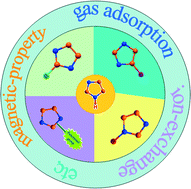The roles of imidazole ligands in coordination supramolecular systems
Abstract
Imidazole is a fundamental building unit possessing a conjugated five-membered ring system with two N-donor coordination sites. The parent imidazole nucleus can be derivatized to three types of compounds at the 1-, 2-, or 4-positions, generating 1, 2, or 4-imidazole-containing ligands, or can be endowed with other functional groups to form multi-functional ligands. Imidazole and its derivatives have been widely employed as excellent candidates for targeted metal–organic frameworks (MOFs) in the domain of coordination chemistry. Moreover, recent reports show a boom in exploratory synthesis using imidazole derivatives to construct novel MOFs due to their distinct characteristics. In consideration of the rapidly growing research on imidazole ligands, herein, we would like to highlight the recent advances in the rational design of MOFs based on imidazole derivatives from our and other research groups; we would also like to provide new insights into the rational design of organic tectons and the construction of these advanced crystalline materials with desirable properties and functionalities.


 Please wait while we load your content...
Please wait while we load your content...